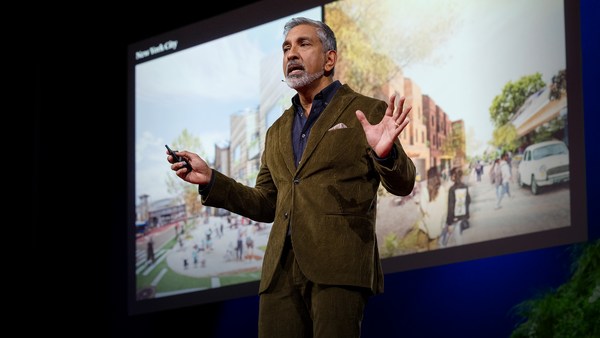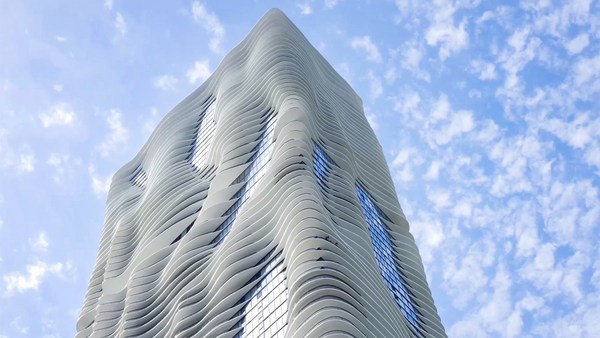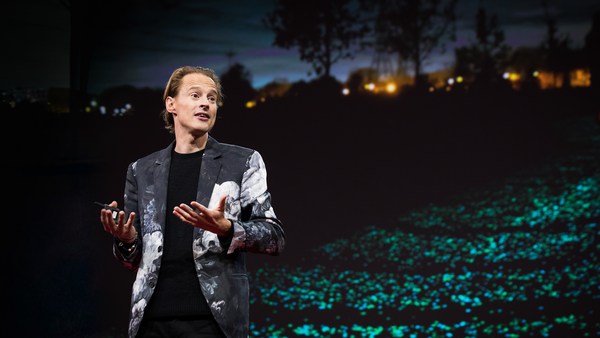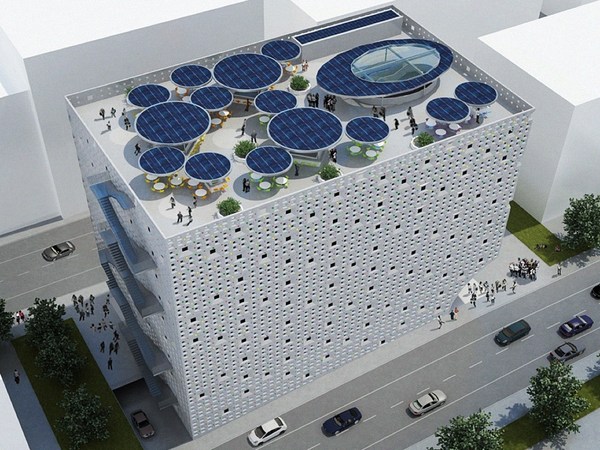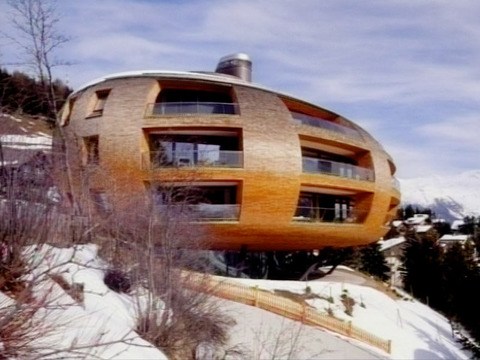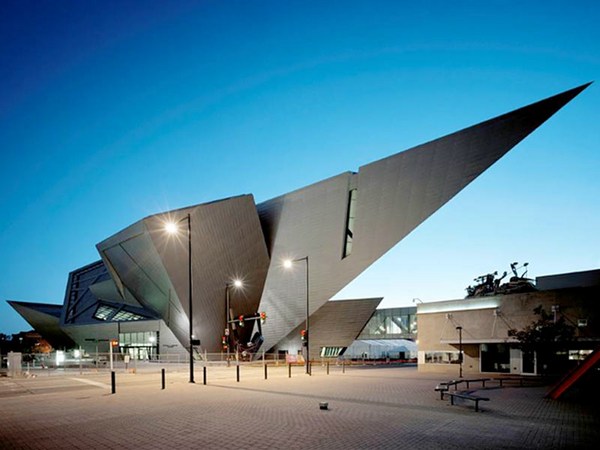So have you ever walked in front of a glass facade and see yourself in the reflection and try to check yourself out? Oh wait, wait, I forgot -- the glass facade is there not for you, but it's for the people on the inside to get a great view out. And they're probably looking at you picking the spinach from your teeth.
(Laughter)
Have you ever walked in a city, come upon a very large commercial building, and in the very hot heat of the summer, the doors fly open, you feel that air-conditioned air come out and blast you, and you just sit there and wallow in that cool air? Oh wait, I forgot, that cool air is for the people on the inside. It's a private building. They won't even let you in to use a bathroom.
(Laughter)
Have you ever wondered why cities get hotter and hotter every year? Oh, wait, I forgot. In order to cool these buildings, the air conditioning systems have to give off air and emit it to the atmosphere, making it hotter and hotter every year, contributing to the heat island effect.
So I'm an architect, a building tech innovator, and a 10,000-step-a-day pedestrian. And I want to talk about how buildings can not only benefit the people on the inside, but they can actually improve life for those on the outside.
So if you go back into history, things were different, right? In the cave, humans had to only worry about the interior, the outside facade was designed by nature. Once leaving the cave, humans then started to stack rocks to make shelter and in doing so inadvertently made some the earliest facades. From there, culture refined, building construction techniques refined, they discovered that the outside facade that's very public-facing can actually tell stories and narratives. It could be used for public service. So they can tell stories about the family, the histories, the conquests, the wealth, the status, all these types of things appeared on facades, and facades became a thing.
So fast forward, we have new technologies, new materials. We're able to thin out the building so it's transparent, the facade itself. But the problem is, glass is a very poor insulator. And that glass then can let the heat in, the cool in, and we had to develop big air-conditioning systems, heating systems to make the interiors even tolerable to stay in.
And more recently, we want to keep that transparency. We want the glass, the view. But in order to do that and make the systems efficient, we had to expand that facade system again. So it's highly engineered now to keep out the heat, the cold, the moisture and glare. So all these systems, in order to make it happen, even have four panes of glass to do it. It's comfortable, it works. But what do we do next?
So I would like to propose that that thickness of the facade still be used to make people on the inside comfortable. But can we think about the outside portion of the facade benefiting people on the outside? Can we actually think about those thousands of square feet of surface area? No, millions of square feet of surface area inside the city and use it for the public? Can we use it for infrastructure and for public good?
So I'm going to show you a few technologies of other people that do that. Here, we can make habitats for animals, ecosystems like these for bees, birds, bats, all kinds of animals are even important to cities. This is a habitat for microorganisms. They're invisible, but they're essential to our livelihood, just like the microbiomes inside your gut. Think about the probiotic qualities of it. The same thing has to happen to cities. Water is an important resource. And so in this system it not only collects water, but it also can purify it as well as store it in a hyperlocalized way. So that places where water security is an issue starts to eliminate and reduce. Think about areas that have drought. And we can also modulate the surfaces, perforate the different types of materials in order to reduce the amount of noise pollution in streets. So think about garbage trucks, sirens, honking horns. That type of stuff can actually diminish with new technologies.
In my own work, I look at architecture as something that can contribute positively to sustainability, to equity and to wellness. I'm going to show you two technologies at different levels of development that I use and apply to public health issues.
So the first one is a smog-eating panel for architecture. And in this case, it actually starts to filter particulate matter and noxious waste in cities in urban-canyon areas. So an urban canyon is when a street is lined by two very tall buildings on both sides, right, forming a canyon-like scenario. And what happens is in these areas, the air movement is very predictable. It comes from prevailing winds, from thermal convection, from the movement of vehicles in there. And it moves in a circular pattern where it makes it very difficult for the heavy particulate matter to escape. So therefore it just keeps going through and accumulates in the bottom over time, more and more. So what we're trying to do is modulate the surface so the surface can allow those prevailing winds to flow into these tubes, to filter that smog and move out as fresh air. So you can see here we use models and wind tunnels that we build as well as simulation modeling to test it. We pack the tubes together so that we can maximize the efficacy of it, as well as minimize the material it takes to make it. And we put them in such a position of where that wind flow is actually going, and so that it would have an easy time going into the tubes, cleaning the air and coming out as fresh air. We also use the thermal convection model, where in the case the pavement is heating the air, that hot air wants to rise up the face of the building. They can go into these tubes also to filter and then send out fresh air. So it's done in a very passive way.
And not only do we try to apply this to building facades so that the facades are doing the cleaning, we want to actually design these bus shelters that can use this kind of technology, bringing the freshest pockets of air to the people who spend the most amount of time on the streets breathing the worst air.
Another technology that I'm working on is a self-shading window system. Here you can see it. Basically what it does is it shades the interior automatically so that you can use less energy on air conditioning. The idea came from using these thermo bimetal material, which is a material that curls when heated. And we make these very low-tech robots that we do for fun in our office. I know, everybody chuckles when they see it, and it's important that you know that because what happens is people get connected to them as if they're little pets, as if they are alive. And even we name them. This one's actually called Roly Poly.
(Laughter)
So from there, the idea was that we use this thermo bimetal on the facade of a building so that it actually can react to the outdoor environment. And through the course of a day, through the course of a year, as the temperature changes all the time, the building would also change to follow that. And if we can animate a building, then possibly we can get people to also feel more connected to the building, like their pets. And if we do that, we can make people smile more, they can cherish their buildings and they can even feel protective of their cities. So therefore the happiness level of the city can go up as well as mental health.
So we embrace this idea of putting bimetal in the facade. In this case, it's actually in the cavity of a double-glazed standard window system. And we allow these little critters, again like butterflies, to flutter around and flip. So when the heat comes in ... You can see simulated like the sun, these pieces will flip over and respond to any changes outside. What happens, too, is when they flip, you can still see pretty well through the system, it doesn't block your view so that it turns like into a blackout situation. And then when the sun goes away, they go back to their original position.
So you know, what happens, too, is because it's a pixilated system, we can put graphics on it. It opens and closes whenever it wants to so that you can start to see the graphics. The result is awe-inspiring. It’s biophilic, and it’s magical. And I'm happy to say that it's also safe for birds, right? Birds on the outside. So it's actually a great thing. We're hoping to put this technology onto buildings as soon as the end of this year, so stay tuned for that.
So how can we get a lot of these cool technologies on buildings? This is the big question. I have three suggestions. The first one is change policy. Can we require owners and and contractors and real estate developers to spend a percentage of their construction cost on public-centric technologies for facades? Can we do that?
Two, think entrepreneurially. Can owners actually rent, lease, sell this facade to others for infrastructure? Can it be to agriculture? Can it be to even not-for-profit situations? Can it be for utility companies? There's a lot of possibilities that can happen.
And three, advocate for change. Renters inside the buildings must start to demand that their building facades are much more magnanimous. Because think about it: everybody in these buildings must come out to the streets, too. And together we can actually enjoy the improvements to our society and public health.
So next time you go out into a city and you're walking around, look carefully at the buildings. They don't have to be just a pretty face. They can serve a bigger purpose.
Thank you.
(Applause)
